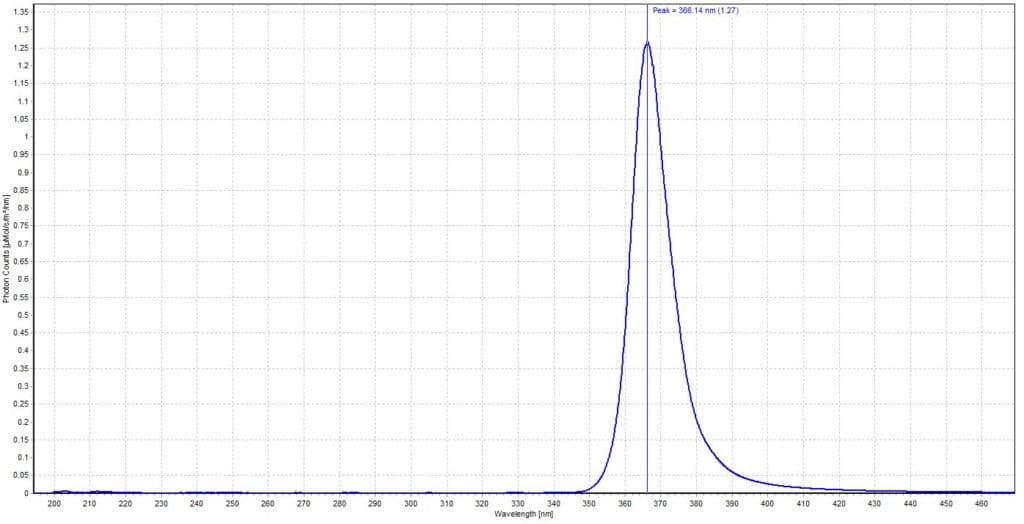UV Radiometry Spectra
Radiometry deals with the measurement of all optical radiation inclusive of the visible portion of this radiant energy. Irradiance is a parameter of radiometry that describes the amount of radiant power upon a surface per unit area. These measurements can be done in the UV, VIS and NIR wavelength ranges.
Irradiance measurements are useful in a wide range of industries and application, ranging from astronomy and solar simulator characterization, to LED characterization and verification. Absolute irradiance measurements can give the user useful information on the light sources radiant flux (power emitted) and energy emitted
Spectroradiometry is the measurement of light energy at individual wavelengths within the electromagnetic spectrum. It can be measured over the entire spectrum or within a specific band of wavelengths. This experiment will focus on determining the irradiance values and radiant flux values for several UV LED diodes.
System Description
The setup for this experiments an AvaSpec-ULS2048x64-EVO, coupled with an AvaaSphere-50-IRRAD integrating sphere, to measure the absolute irradiance of several UV LED diodes and strips.
Alongside the cooled AvaSpec-ULS2048x64TEC-EVO with low-noise detector, Avantes also offers the more cost-effective, uncooled AvaSpec-ULS2048x64-EVO. With its standard 2048×64 back-thinned detector, this spectrometer is perfect for less demanding applications in the UV and NIR range. For applications that require integration times lower than 2 seconds, the cooling option is often not needed. For example, this uncooled AvaSpec-ULS2048x64-EVO has an established track record in various DOAS applications all over the world because of its high UV response and 0.9 mm detector height that enables detecting the wavelengths of interest. Options include an order-sorting filter to reduce second-order effects and purge ports for deep-UV measurements. The AvaSpec-ULS2048x64-EVO comes with a wide range of slit sizes and gratings and can be configured with SMA or FC/PC fiber-optic entrance connectors. The AvaSpec-ULS2048x64-EVO uses the AS-7010 electronics board offering USB3 (10 times faster than USB2), Gigabit Ethernet and better signal processing. For this experiment, the AvaSpec-ULS2048x64-EVO is optimized for the range of 200 nm to 450 nm, making it ideal for UV measurements.
An integrating sphere works as a light collector. The light collected can be used as a diffuse illumination or measurement source. The basic principle is that light enters the sphere through the sample port, goes through multiple reflections on the highly reflective, Lambertian surface of the sphere and is scattered uniformly around the interior of the sphere. Behind a baffled port inside the sphere which is independent of the angular properties of the sample port, a fiber-optic cable collects a homogenized light signal and carries it to the spectrometer. The baffle is very significant as it prevents first reflections from entering the detection fiber. The irradiance version of the integrating sphere, used in this experiment, can be used for measurements of light sources, such as lasers, LEDs and incandescent sources. For irradiance measurements of 5 mm cylindrical LEDs, a special adapter is available for the AvaSphere-50/80-IRRAD. This adapter ensures correct and reproducible positioning of the LEDs inside the sphere.
Methodology
For this experiment, we will be utilizing the AvaSpec-ULS2048x64 with an AvaSphere-50-IRRAD that has been irradiance calibrated to measure the irradiance values of several UV LED samples.
For our data collection, we will be utilizing the Irradiance package in the AvaSoft software.
Test Data and Results
The following images show the absolute irradiance spectra for multiple LED samples
Analysis
Our irradiance calibrated system did an excellent job at measuring the irradiance value for our four UV LED samples. The first sample has a measured irradiance value of 25235 uWatt/cm2, the second sample has a measured irradiance value of 23247 uWatt/cm2, the third sample has a measured irradiance value of 622.75 uWatt/cm2, and fourth sample has a measured irradiance value of 554.37 uWatt/cm2. This information can be used to classify the LED’s and determine if they meet the necessary requirements for use.
Conclusion
Measurement setups based on compact fiberoptic spectrometers are versatile and can be used in various applications. Some applications, however, require not only accurate wavelength information, but also the possibility to compare intensities. To enable this, the spectrometer system needs to be intensity calibrated to convert the shape provided by the raw data into the actual spectral shape of the measured object. The overall measurements provided by Avantes calibrated equipment are well suited for these types of applications. To see how Avantes spectrometers can assist you with your measurements, please contact your Avantes sales rep.
Design Your Own System
Connect with an Avantes Engineer today to begin designing your ideal LED metrology system
 My Cart
My Cart 




